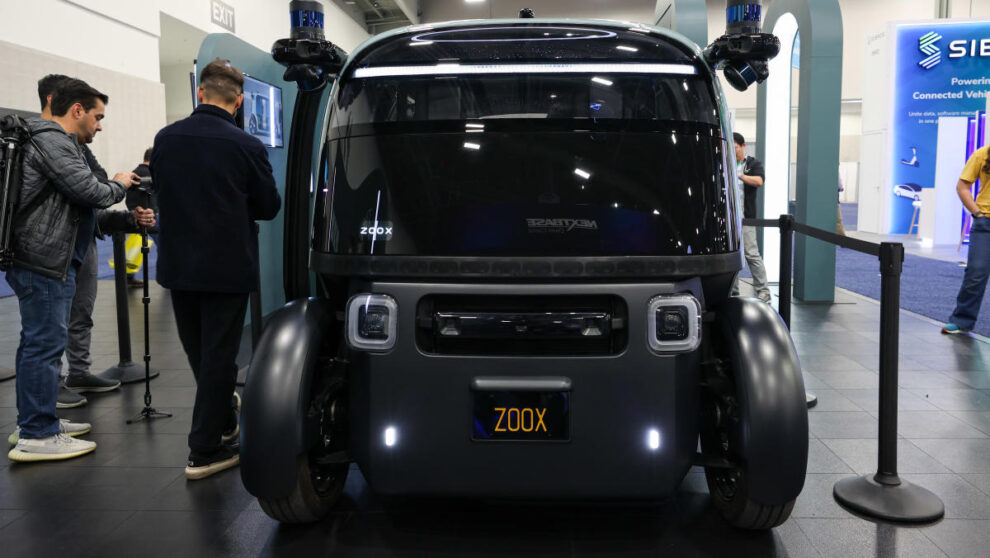Zoox CEO Aicha Evans joins Yahoo Finance Live to discuss approval of its self-driving auto by the California DMV, the state of the autonomous vehicle industry, and Amazon’s ownership of the company.
Video Transcript
– No steering wheel. No pedals. No driver, for that matter. No problem. Amazon-owned Zoox says it’s the first-ever purpose built robotaxi with no manual controls to operate on public roads. Zoox CEO Aicha Evans joins us now to tell us more about this incredible vehicle.
Nice to see you. In as close as you can get to layman’s terms, how does this thing work?
AICHA EVANS: Well, first of all, thank you for having me. Much appreciated. We use technology around AI, industrial design, and also sensors and computes to basically have a robotaxi that takes you from point A to point B.
The same way today when you use your app to order somebody to come and take you, well this time, with Zoox the robot or the robotaxi will come pick you up and get you where you need to and drop you off.
– So Aicha, it’s very, very cool. I think there’s a lot of hype surrounding this. What are the limitations, though, of this, and how are you working to address that so you will be able to use this vehicle more often?
AICHA EVANS: Safety is absolutely critical. You need to be safe in all situations. Second, it’s sort of a little bit of a two-headed situation. On the one hand, humans make a lot of mistakes driving, as measured by fatalities from crashes. But on the other hand, 40,000 fatalities is not acceptable.
But we also drive, collectively, almost 100 million miles for each fatality. And so basically, we’re also very good at driving, and that’s because we’re very good humans at handling unforeseen, unpredictable scenarios. And so a lot of testing, a lot of quantifiable data and metrics to make sure we’re safe, and deploying a little at a time, not at scale from the get-go.
– So Aicha, the limitations were just there on the screen, including tops out at 40 miles an hour, can only right now be used Saturdays and Sundays during daylight hours, and not during inclement or bad weather. How close are you to overcoming any or all of these limitations?
AICHA EVANS: Very close. Zoox, we’ve been extremely consistent since inception in 2014. They are the vehicle capabilities. So for example, on speed, we’ve demonstrated that we can go up to 75 miles an hour. However, from a deployment standpoint, what we’re clearing ourself from a safety standpoint is up to 40 miles an hour.
So you can expect a steady drumbeat of extensions of our permit that commiserates with what we’re able to do on public road. And we call that the operational design domain. And you can expect several upgrades yearly, all the way to our first paying customer, and then going after several cities.
– Aicha, let’s talk a little bit more about the use case for this because I think a lot of us, when we were talking about at least in our morning meeting, we were saying whether or not this would be used more as a corporate shuttle, shuttling employees from one place to the next, which I know is very popular out in California. If it could be used for deliveries. What do you see as the use case for this in, say, five years from now?
AICHA EVANS: So first step is humans and let’s take the United States. We’ve already proven– there are companies that exist today. We’ve already proven that we like mobility on demand. For example, I live south of San Francisco. But every time I’m headed to San Francisco, and especially on an evening for a date with high heels on, I order a mobility on demand service.
And so the demand is there. So that’s the first step. It’s basically instead of a human-driven passenger car, the robotaxi will take you, and then take on the next customer. And then eventually, we’d like to make a dent on personal car ownership. I mean, transportation is really a service at the end of the day. We’d like to get to the point where we start having less cars on the road and have higher utilization. That doesn’t mean all passenger cars will go away, but making a dent in that would be good for all of us– society, the environment, and so on.
– You’re Amazon-owned, so the obvious question is do you foresee a time when these are making Amazon deliveries? And if I could just tag one on to that, in terms of fully autonomous vehicles, we all think of Elon Musk. Just had 360,000 vehicles recalled. How different is your technology than the one employed at Tesla?
AICHA EVANS: That was three questions in one. All right.
– Just two.
AICHA EVANS: Just two? All right. OK, so let’s start with the second one. Look, we built something very different than what Tesla does. I can’t really comment on what’s going on with them, not because I’m evading it, but because I don’t actually know.
What I do know is that we are not building something that is occasionally driverless, meaning that requires somebody behind the wheels with human controls and ready to take over. We’re building something that’s fully autonomous, fully driverless, and that goes from point A to point B, and then forward.
As far as Amazon, it’s been a fantastic partnership. Yeah, I mean, what one could imagine at some point, working on maybe some aspects of packages. But right now, we’re very grateful. We’ve been extremely focused. This is a great opportunity.
I think Amazon has said that it’s one of the growth initiatives that they are investing in. It’s a big market, we already know it. It’s just the structure of that market is not very good right now, and that gets solved with autonomy. So focus, focus, focus, execute, and then we’ll figure out adjacencies.
– We are excited to see where this all leads. Aicha Evans, excuse me, CEO of Zoox, thanks so much for joining us.
AICHA EVANS: Thank you for having me.








